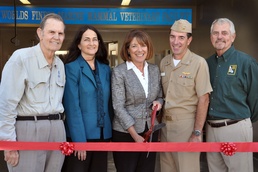
SAN DIEGO - A 12,000-square-foot, state-of-the-art addition to Space and Naval Warfare Systems Center Pacific’s existing Marine Mammal Medical Center was officially dedicated Sept. 25 with a ribbon-cutting ceremony attended by U.S. Rep. Susan Davis, Commanding Officer Capt. Joe Beel, Executive Director Carmela Keeney, and Navy Senior Scientist for Animal Care Dr. Sam Ridgway, who is also president of the National Marine Mammal Foundation.
Davis, whose congressional district includes Point Loma, Calif., sponsored legislation in 2009 to improve veterinary care for the U.S. Navy Marine Mammal Program’s dolphins and sea lions. Groundbreaking commenced in August 2011.
Since the 1960s, the United States has trained dolphins and sea lions to detect sea mines and swimmers, and to recover inert torpedoes and testing objects used in Navy exercises.
Following the ribbon-cutting, Keeney thanked Davis for her continued support and efforts in securing funding for the medical center expansion, the first Space and Naval Warfare (SPAWAR) Systems Center Pacific military construction project in two decades. Keeney recognized Naval Facilities Engineering Command Southwest for taking the lead on the project, as well as efforts by SSC Pacific’s safety, environmental and facilities groups.
Keeney also saluted Ridgway, often called the “Father of the Navy’s Marine Mammal Program,” and his many contributions to marine mammal care, as well as the contributions of program manager Mike Rothe. She reminded attendees that ultimately, all efforts were focused on providing the best marine mammal care possible so, in turn, the Marine Mammal Program can continue to succeed in its missions.
Beel also thanked the many people whose efforts contributed to the completion of the new facility. He emphasized the importance of SSC Pacific’s Marine Mammal Program, and supporting the warfighter amid an increased demand for mine-hunting assistance in light of recent turmoil in the Persian Gulf region.
Beel additionally complemented the unique example of Army Soldiers (veterinarians) working with Navy civilians and active-duty Sailors to provide such an incredible warfighting capability. The facility’s expanded capabilities will improve the delivery of veterinary care, which enhances the animals' readiness to deploy for mine warfare and force protection missions.
Davis thanked leadership for the invitation to participate in the dedication of the program’s new facility, and expressed her firm support for the Marine Mammal Program and its mission of providing critical national security capabilities.
"The Navy Marine Mammal Program is critical to national security and I am proud to be a part of the expansion of the Navy marine mammal medical facility at SPAWAR Systems Center Pacific,” Davis said.
“This state of the art facility provides additional capacity and the latest medical and laboratory equipment to Navy civilian personnel and Army veterinary staff responsible for providing the highest possible care to marine mammals. With this investment, the Navy will have an even greater ability to care for these amazing animals."
A walk through the expansion’s 1,260 square feet of space highlighted the facility’s improved functionality and state-of-the-art medical capabilities, including the creation of a new surgery suite, laboratory, pharmacy, and pathology room. Mechanical, electrical and information technology improvements will support new diagnostic imaging and patient monitoring capabilities.
As demonstrated by staff team members, SSC Pacific veterinarians will have access to diagnostic images, the animal's medical history, along with any other health data - in the same room while they are performing a procedure.
“With increased space and new equipment, including state-of-the-art blood analyzers, we will be able to load up our cart and take it to the animals,” said Dr. Eric Jensen, who is the managing clinical veterinarian for the U.S. Navy Marine Mammal Program.
“Now, while we’re working, we can have all our equipment right at hand and we’ll never have to move the patient.”
Jensen also pointed out the medical center’s expansion makes it a one-of-a-kind surgical center, the most advanced in the world, where fellow veterinary professionals from Sea World or Disney can now tour the cutting-edge facilities, and, take back ideas on integrating less-invasive care procedures for their animal hospitals.
Program veterinarians will also be able to use the facility's new pathology area to access samples from the past to look at historic cases with new technology, hoping to answer previously unanswered questions regarding marine mammal health and longevity.